Comprehensive Financial Performance Analysis Case Study Report
VerifiedAdded on 2022/08/24
|7
|1346
|18
Case Study
AI Summary
This case study examines a company's financial performance, focusing on profitability ratios such as gross, operating, and net profit margins. The analysis reveals declining profitability despite increasing sales, prompting an investigation into cost control and pricing strategies. Stakeholder interests, particularly those of shareholders, are considered, including the impact of dividend payments on financial health. The study highlights the need for improved cost management, reevaluation of pricing strategies, and potential expansion of services to enhance sales and overall financial performance. The analysis emphasizes the importance of balancing stakeholder satisfaction with long-term financial sustainability. The report also includes a calculation of financial ratios and references to relevant academic research.
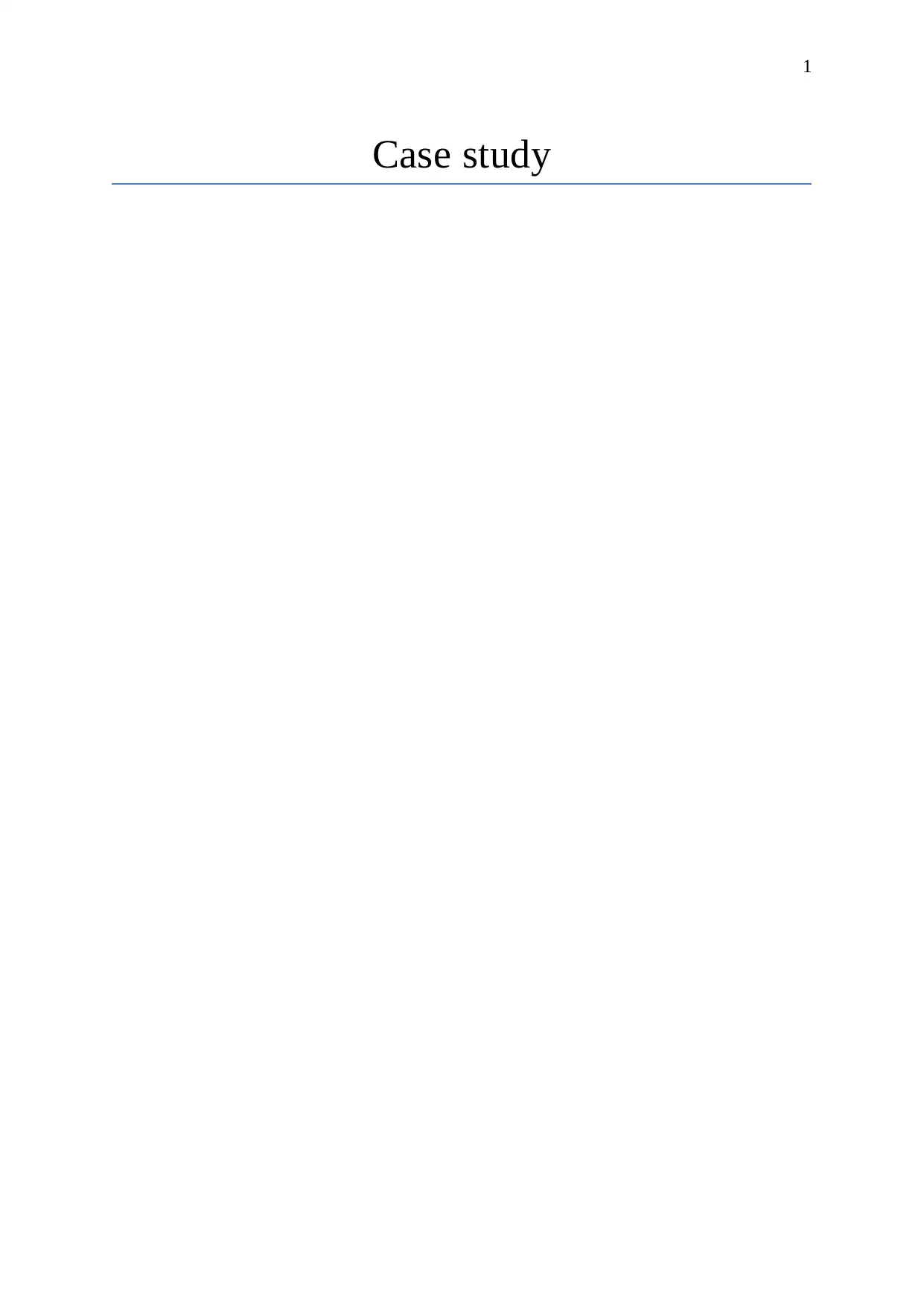
1
Case study
Case study
Paraphrase This Document
Need a fresh take? Get an instant paraphrase of this document with our AI Paraphraser
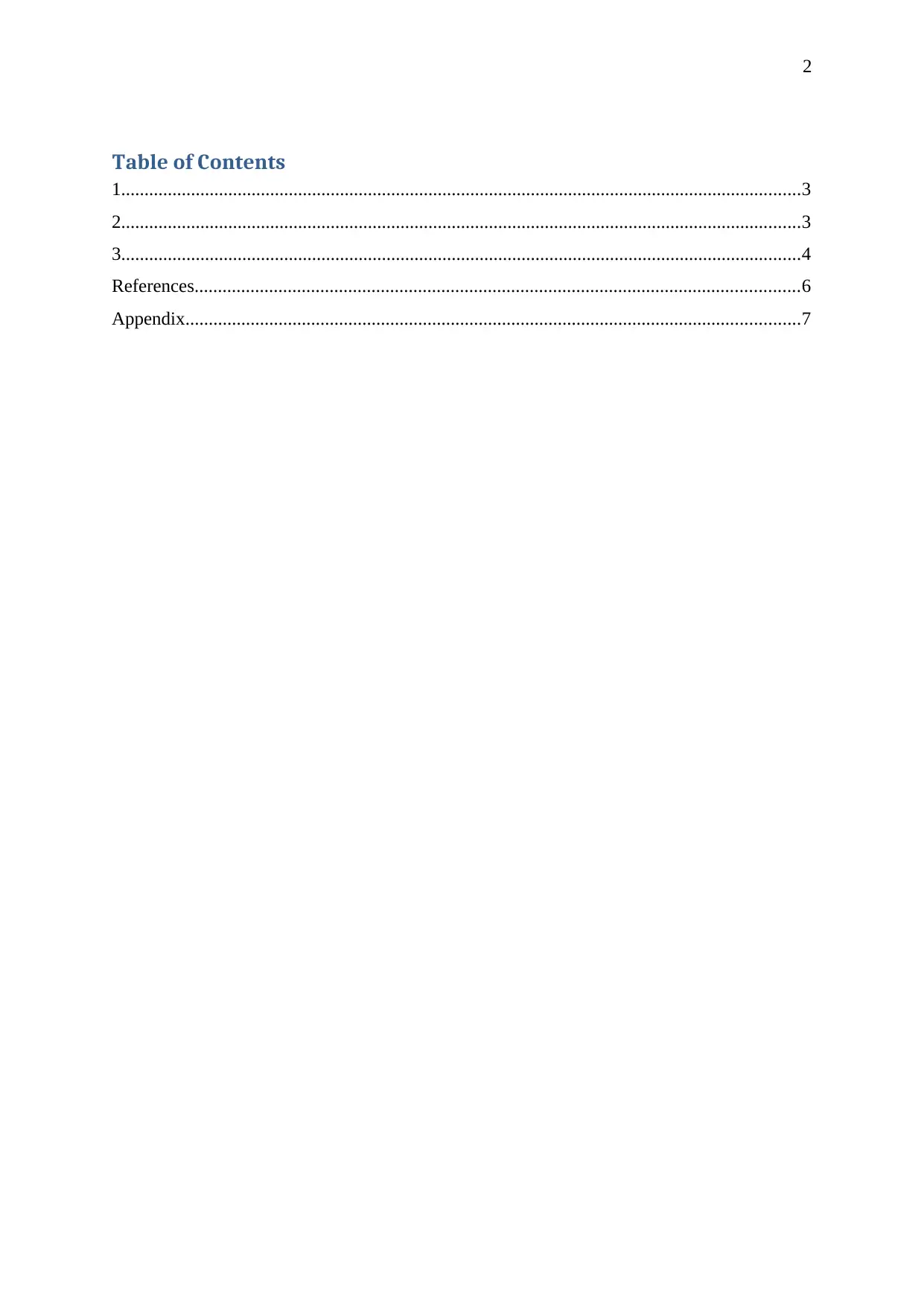
2
Table of Contents
1..................................................................................................................................................3
2..................................................................................................................................................3
3..................................................................................................................................................4
References..................................................................................................................................6
Appendix....................................................................................................................................7
Table of Contents
1..................................................................................................................................................3
2..................................................................................................................................................3
3..................................................................................................................................................4
References..................................................................................................................................6
Appendix....................................................................................................................................7
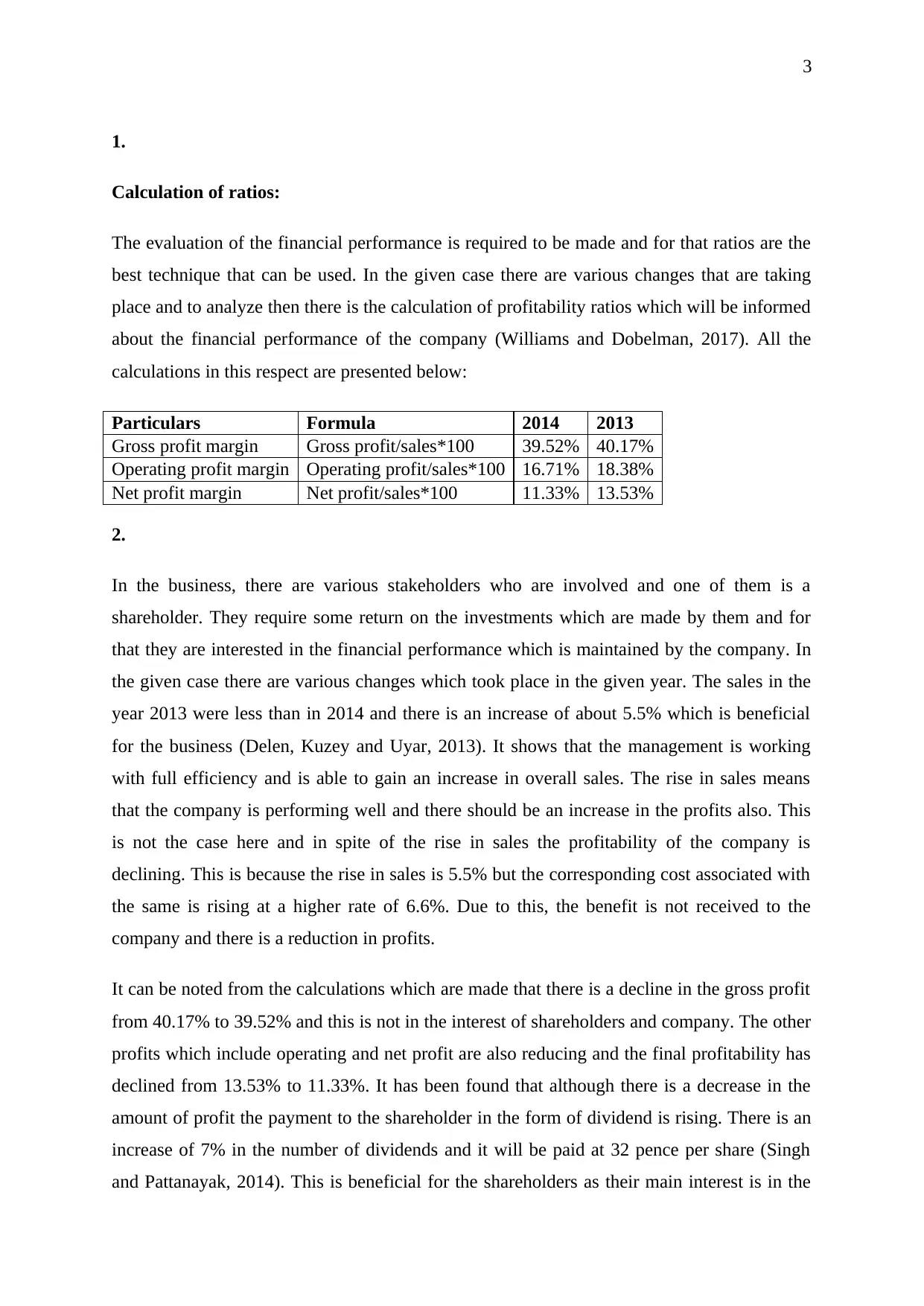
3
1.
Calculation of ratios:
The evaluation of the financial performance is required to be made and for that ratios are the
best technique that can be used. In the given case there are various changes that are taking
place and to analyze then there is the calculation of profitability ratios which will be informed
about the financial performance of the company (Williams and Dobelman, 2017). All the
calculations in this respect are presented below:
Particulars Formula 2014 2013
Gross profit margin Gross profit/sales*100 39.52% 40.17%
Operating profit margin Operating profit/sales*100 16.71% 18.38%
Net profit margin Net profit/sales*100 11.33% 13.53%
2.
In the business, there are various stakeholders who are involved and one of them is a
shareholder. They require some return on the investments which are made by them and for
that they are interested in the financial performance which is maintained by the company. In
the given case there are various changes which took place in the given year. The sales in the
year 2013 were less than in 2014 and there is an increase of about 5.5% which is beneficial
for the business (Delen, Kuzey and Uyar, 2013). It shows that the management is working
with full efficiency and is able to gain an increase in overall sales. The rise in sales means
that the company is performing well and there should be an increase in the profits also. This
is not the case here and in spite of the rise in sales the profitability of the company is
declining. This is because the rise in sales is 5.5% but the corresponding cost associated with
the same is rising at a higher rate of 6.6%. Due to this, the benefit is not received to the
company and there is a reduction in profits.
It can be noted from the calculations which are made that there is a decline in the gross profit
from 40.17% to 39.52% and this is not in the interest of shareholders and company. The other
profits which include operating and net profit are also reducing and the final profitability has
declined from 13.53% to 11.33%. It has been found that although there is a decrease in the
amount of profit the payment to the shareholder in the form of dividend is rising. There is an
increase of 7% in the number of dividends and it will be paid at 32 pence per share (Singh
and Pattanayak, 2014). This is beneficial for the shareholders as their main interest is in the
1.
Calculation of ratios:
The evaluation of the financial performance is required to be made and for that ratios are the
best technique that can be used. In the given case there are various changes that are taking
place and to analyze then there is the calculation of profitability ratios which will be informed
about the financial performance of the company (Williams and Dobelman, 2017). All the
calculations in this respect are presented below:
Particulars Formula 2014 2013
Gross profit margin Gross profit/sales*100 39.52% 40.17%
Operating profit margin Operating profit/sales*100 16.71% 18.38%
Net profit margin Net profit/sales*100 11.33% 13.53%
2.
In the business, there are various stakeholders who are involved and one of them is a
shareholder. They require some return on the investments which are made by them and for
that they are interested in the financial performance which is maintained by the company. In
the given case there are various changes which took place in the given year. The sales in the
year 2013 were less than in 2014 and there is an increase of about 5.5% which is beneficial
for the business (Delen, Kuzey and Uyar, 2013). It shows that the management is working
with full efficiency and is able to gain an increase in overall sales. The rise in sales means
that the company is performing well and there should be an increase in the profits also. This
is not the case here and in spite of the rise in sales the profitability of the company is
declining. This is because the rise in sales is 5.5% but the corresponding cost associated with
the same is rising at a higher rate of 6.6%. Due to this, the benefit is not received to the
company and there is a reduction in profits.
It can be noted from the calculations which are made that there is a decline in the gross profit
from 40.17% to 39.52% and this is not in the interest of shareholders and company. The other
profits which include operating and net profit are also reducing and the final profitability has
declined from 13.53% to 11.33%. It has been found that although there is a decrease in the
amount of profit the payment to the shareholder in the form of dividend is rising. There is an
increase of 7% in the number of dividends and it will be paid at 32 pence per share (Singh
and Pattanayak, 2014). This is beneficial for the shareholders as their main interest is in the
⊘ This is a preview!⊘
Do you want full access?
Subscribe today to unlock all pages.

Trusted by 1+ million students worldwide
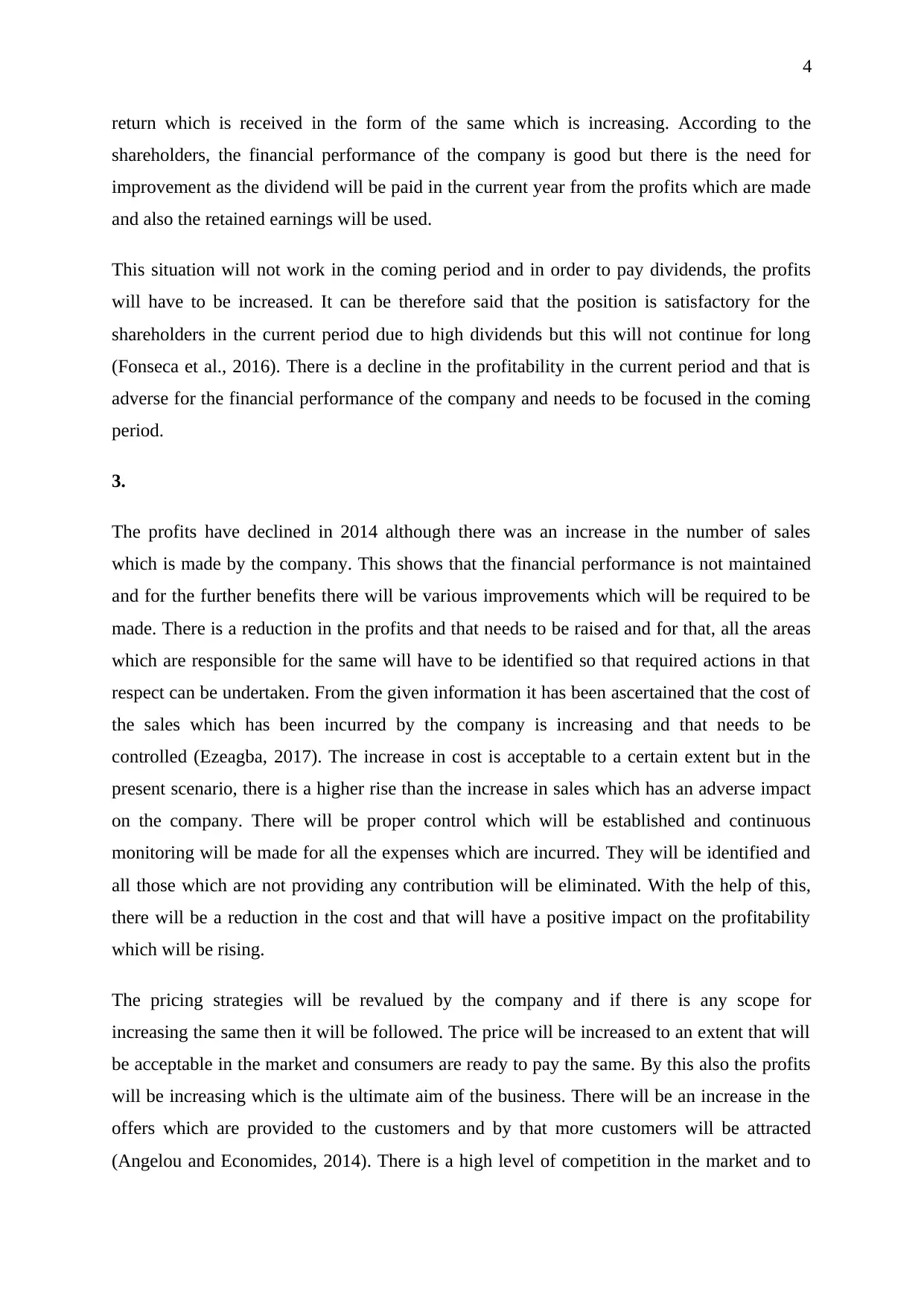
4
return which is received in the form of the same which is increasing. According to the
shareholders, the financial performance of the company is good but there is the need for
improvement as the dividend will be paid in the current year from the profits which are made
and also the retained earnings will be used.
This situation will not work in the coming period and in order to pay dividends, the profits
will have to be increased. It can be therefore said that the position is satisfactory for the
shareholders in the current period due to high dividends but this will not continue for long
(Fonseca et al., 2016). There is a decline in the profitability in the current period and that is
adverse for the financial performance of the company and needs to be focused in the coming
period.
3.
The profits have declined in 2014 although there was an increase in the number of sales
which is made by the company. This shows that the financial performance is not maintained
and for the further benefits there will be various improvements which will be required to be
made. There is a reduction in the profits and that needs to be raised and for that, all the areas
which are responsible for the same will have to be identified so that required actions in that
respect can be undertaken. From the given information it has been ascertained that the cost of
the sales which has been incurred by the company is increasing and that needs to be
controlled (Ezeagba, 2017). The increase in cost is acceptable to a certain extent but in the
present scenario, there is a higher rise than the increase in sales which has an adverse impact
on the company. There will be proper control which will be established and continuous
monitoring will be made for all the expenses which are incurred. They will be identified and
all those which are not providing any contribution will be eliminated. With the help of this,
there will be a reduction in the cost and that will have a positive impact on the profitability
which will be rising.
The pricing strategies will be revalued by the company and if there is any scope for
increasing the same then it will be followed. The price will be increased to an extent that will
be acceptable in the market and consumers are ready to pay the same. By this also the profits
will be increasing which is the ultimate aim of the business. There will be an increase in the
offers which are provided to the customers and by that more customers will be attracted
(Angelou and Economides, 2014). There is a high level of competition in the market and to
return which is received in the form of the same which is increasing. According to the
shareholders, the financial performance of the company is good but there is the need for
improvement as the dividend will be paid in the current year from the profits which are made
and also the retained earnings will be used.
This situation will not work in the coming period and in order to pay dividends, the profits
will have to be increased. It can be therefore said that the position is satisfactory for the
shareholders in the current period due to high dividends but this will not continue for long
(Fonseca et al., 2016). There is a decline in the profitability in the current period and that is
adverse for the financial performance of the company and needs to be focused in the coming
period.
3.
The profits have declined in 2014 although there was an increase in the number of sales
which is made by the company. This shows that the financial performance is not maintained
and for the further benefits there will be various improvements which will be required to be
made. There is a reduction in the profits and that needs to be raised and for that, all the areas
which are responsible for the same will have to be identified so that required actions in that
respect can be undertaken. From the given information it has been ascertained that the cost of
the sales which has been incurred by the company is increasing and that needs to be
controlled (Ezeagba, 2017). The increase in cost is acceptable to a certain extent but in the
present scenario, there is a higher rise than the increase in sales which has an adverse impact
on the company. There will be proper control which will be established and continuous
monitoring will be made for all the expenses which are incurred. They will be identified and
all those which are not providing any contribution will be eliminated. With the help of this,
there will be a reduction in the cost and that will have a positive impact on the profitability
which will be rising.
The pricing strategies will be revalued by the company and if there is any scope for
increasing the same then it will be followed. The price will be increased to an extent that will
be acceptable in the market and consumers are ready to pay the same. By this also the profits
will be increasing which is the ultimate aim of the business. There will be an increase in the
offers which are provided to the customers and by that more customers will be attracted
(Angelou and Economides, 2014). There is a high level of competition in the market and to
Paraphrase This Document
Need a fresh take? Get an instant paraphrase of this document with our AI Paraphraser
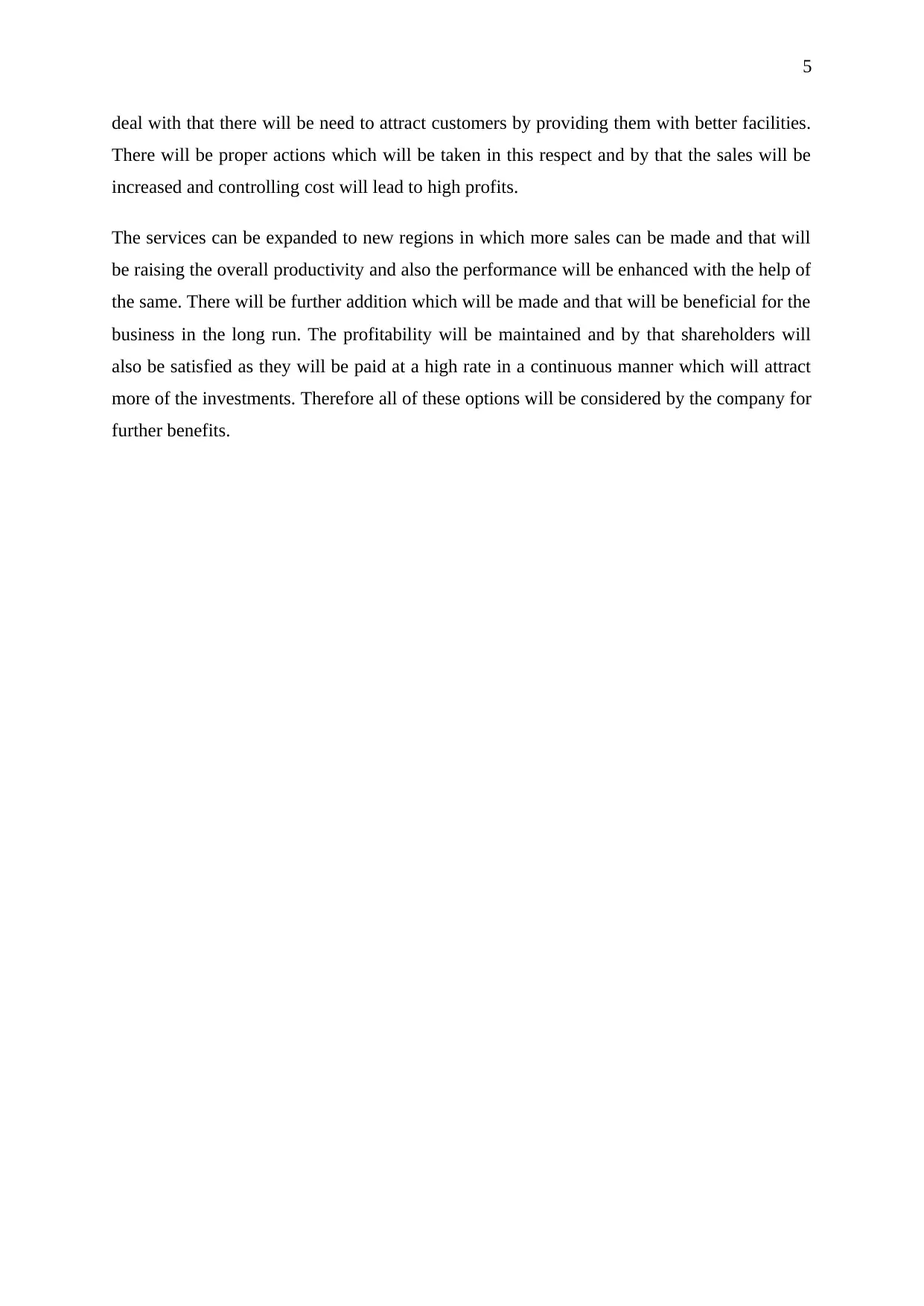
5
deal with that there will be need to attract customers by providing them with better facilities.
There will be proper actions which will be taken in this respect and by that the sales will be
increased and controlling cost will lead to high profits.
The services can be expanded to new regions in which more sales can be made and that will
be raising the overall productivity and also the performance will be enhanced with the help of
the same. There will be further addition which will be made and that will be beneficial for the
business in the long run. The profitability will be maintained and by that shareholders will
also be satisfied as they will be paid at a high rate in a continuous manner which will attract
more of the investments. Therefore all of these options will be considered by the company for
further benefits.
deal with that there will be need to attract customers by providing them with better facilities.
There will be proper actions which will be taken in this respect and by that the sales will be
increased and controlling cost will lead to high profits.
The services can be expanded to new regions in which more sales can be made and that will
be raising the overall productivity and also the performance will be enhanced with the help of
the same. There will be further addition which will be made and that will be beneficial for the
business in the long run. The profitability will be maintained and by that shareholders will
also be satisfied as they will be paid at a high rate in a continuous manner which will attract
more of the investments. Therefore all of these options will be considered by the company for
further benefits.
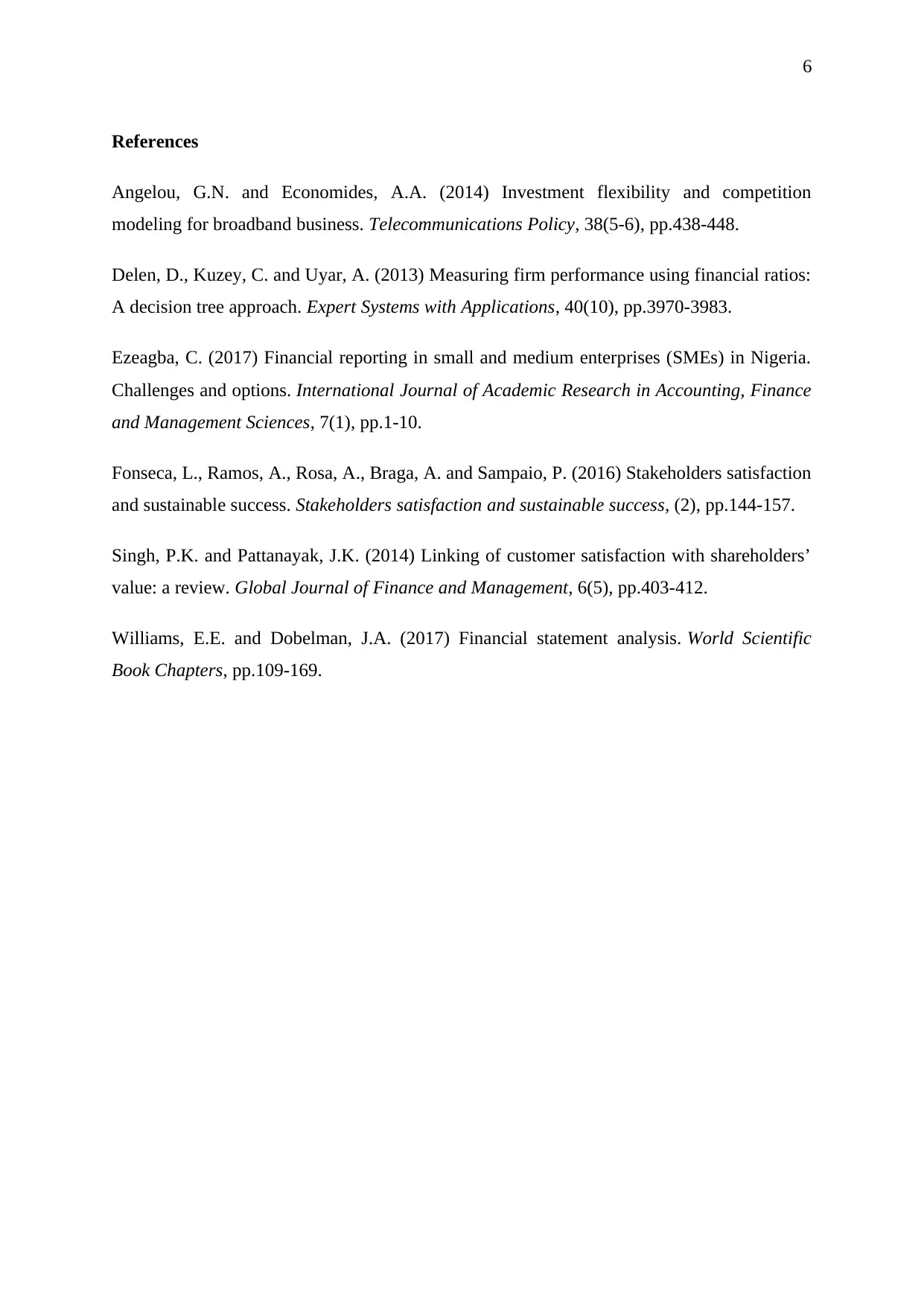
6
References
Angelou, G.N. and Economides, A.A. (2014) Investment flexibility and competition
modeling for broadband business. Telecommunications Policy, 38(5-6), pp.438-448.
Delen, D., Kuzey, C. and Uyar, A. (2013) Measuring firm performance using financial ratios:
A decision tree approach. Expert Systems with Applications, 40(10), pp.3970-3983.
Ezeagba, C. (2017) Financial reporting in small and medium enterprises (SMEs) in Nigeria.
Challenges and options. International Journal of Academic Research in Accounting, Finance
and Management Sciences, 7(1), pp.1-10.
Fonseca, L., Ramos, A., Rosa, A., Braga, A. and Sampaio, P. (2016) Stakeholders satisfaction
and sustainable success. Stakeholders satisfaction and sustainable success, (2), pp.144-157.
Singh, P.K. and Pattanayak, J.K. (2014) Linking of customer satisfaction with shareholders’
value: a review. Global Journal of Finance and Management, 6(5), pp.403-412.
Williams, E.E. and Dobelman, J.A. (2017) Financial statement analysis. World Scientific
Book Chapters, pp.109-169.
References
Angelou, G.N. and Economides, A.A. (2014) Investment flexibility and competition
modeling for broadband business. Telecommunications Policy, 38(5-6), pp.438-448.
Delen, D., Kuzey, C. and Uyar, A. (2013) Measuring firm performance using financial ratios:
A decision tree approach. Expert Systems with Applications, 40(10), pp.3970-3983.
Ezeagba, C. (2017) Financial reporting in small and medium enterprises (SMEs) in Nigeria.
Challenges and options. International Journal of Academic Research in Accounting, Finance
and Management Sciences, 7(1), pp.1-10.
Fonseca, L., Ramos, A., Rosa, A., Braga, A. and Sampaio, P. (2016) Stakeholders satisfaction
and sustainable success. Stakeholders satisfaction and sustainable success, (2), pp.144-157.
Singh, P.K. and Pattanayak, J.K. (2014) Linking of customer satisfaction with shareholders’
value: a review. Global Journal of Finance and Management, 6(5), pp.403-412.
Williams, E.E. and Dobelman, J.A. (2017) Financial statement analysis. World Scientific
Book Chapters, pp.109-169.
⊘ This is a preview!⊘
Do you want full access?
Subscribe today to unlock all pages.

Trusted by 1+ million students worldwide

7
Appendix
Appendix
1 out of 7
Related Documents
Your All-in-One AI-Powered Toolkit for Academic Success.
+13062052269
info@desklib.com
Available 24*7 on WhatsApp / Email
![[object Object]](/_next/static/media/star-bottom.7253800d.svg)
Unlock your academic potential
Copyright © 2020–2025 A2Z Services. All Rights Reserved. Developed and managed by ZUCOL.





